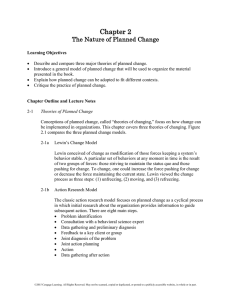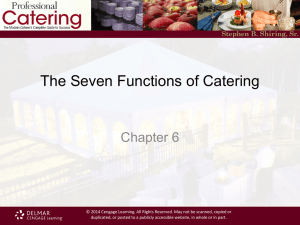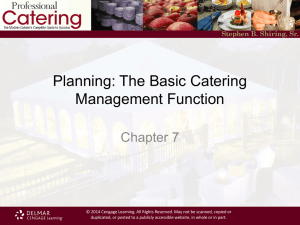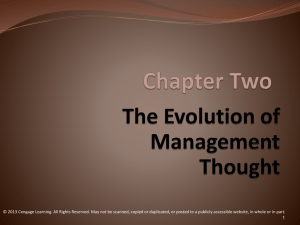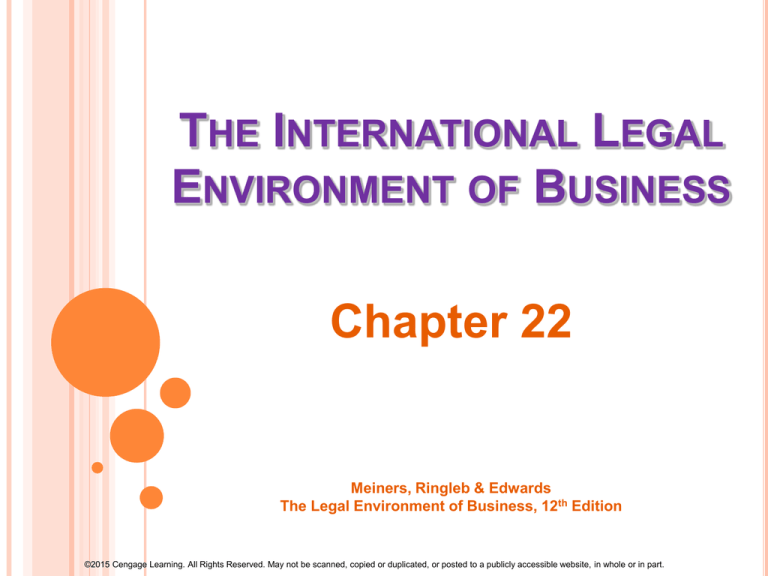
THE INTERNATIONAL LEGAL
ENVIRONMENT OF BUSINESS
Chapter 22
Meiners, Ringleb & Edwards
The Legal Environment of Business, 12th Edition
©2015 Cengage Learning. All Rights Reserved. May not be scanned, copied or duplicated, or posted to a publicly accessible website, in whole or in part.
INTERNATIONAL LAW AND BUSINESS
International Trade Agreements
U.S. Import/Export Policies
Business Structures in Foreign Markets
Foreign Corrupt Practices Act
International Contracts
International Dispute Resolution
©2015 Cengage Learning. All Rights Reserved. May not be scanned, copied or duplicated, or posted to a publicly accessible website, in whole or in part.
THE INTERNATIONAL BUSINESS ENVIRONMENT
Includes all business transactions that involve entities from
two or more countries
Movement of goods across countries
Movement of services across countries
Issues regarding capital
Issues regarding personnel of multinational enterprises
Differences include risks in
•
Financial
•
Political
•
Regulatory
©2015 Cengage Learning. All Rights Reserved. May not be scanned, copied or duplicated, or posted to a publicly accessible website, in whole or in part.
ORIGINS OF INTERNATIONAL LAW
Commercial codes date back to Egypt in 1400 B.C.
Early trade centered around law of the sea
Greek/ Roman Empires both had codes of
international trade
Middle Ages: Lex Mercatoria (Merchant Law) –
Governed trading customs in Europe
Today’s codes still partially derived from early efforts
©2015 Cengage Learning. All Rights Reserved. May not be scanned, copied or duplicated, or posted to a publicly accessible website, in whole or in part.
SOURCES OF INTERNATIONAL LAW
Individual countries create their own laws
Trade agreements between countries
Worldwide/regional organizations, i.e.
United Nations
European Union (EU)
No universal international court system for resolving
international conflicts of businesses
Difficult to enforce decisions and contracts
See Exhibit 22.1
©2015 Cengage Learning. All Rights Reserved. May not be scanned, copied or duplicated, or posted to a publicly accessible website, in whole or in part.
INTERNATIONAL TRADE AGREEMENTS
Improve economic relations of countries
Cover variety of commercial issues
Tax agreements prevent double taxation
Examples:
North American Free Trade Agreement (NAFTA, 1992)
Canada/US/Mexico
Regional treaty
General Agreement on Tariffs & Trade (GATT) replaced in 1995 by
World Trade Organization (WTO)
International Treaty
WTO has authority to investigate & rule on government
subsidies that give unfair advantage to producer in a country
Also looks at countervailing measures
Helps with worldwide protection of intellectual property
©2015 Cengage Learning. All Rights Reserved. May not be scanned, copied or duplicated, or posted to a publicly accessible website, in whole or in part.
U.S. IMPORT POLICY
Limits on imports
• To protect domestic
interests
Taxes on imports
Tariffs (Duties) – Taxes
imposed by a
government on imported
goods
Specific tariffs: fixed
duties on products
Ad valorem tariffs: %
of price of product
Harmonized Tariff Schedules –
Standardized, worldwide
classification of goods for
customs officials
Harmonized Tariff Schedule of
the United States (HTSUS)
Each country uses same
codes
Bans on Certain Products – i.e.
weapons, illegal products,
narcotics, national security
concerns, products made from
endangered species
©2015 Cengage Learning. All Rights Reserved. May not be scanned, copied or duplicated, or posted to a publicly accessible website, in whole or in part.
CASE
UNITED STATES V. MEAD CORPORATION
Mead imported “day planner” calendars. Under the tariff (HTSUS) –
general heading for “registers, account books, notebooks . . .and
similar articles.” Under subheading 4820.10 “diaries, notebooks and
address books” subject to 4.0% tariff. Another subheading was for
“other” items NOT subject to a tariff.
“Other” heading applied to planners until 1993. Customs changed
classification to “diaries” and applied 4% tariff. Mead protested, but
Customs did not change.
Mead sued in Court of International Trade (CIT). Court granted
summary judgment for Customs. Mead appealed to Court of Appeals
for Federal Circuit.
It reversed. Held classification by Customs do not get high level of
deference to some regulations because Customs can change
classification without formal notice-and-rule process that occurs for
most substantive regulations.
Also held planners were not “diaries”, as those defined as bound
volumes. Planner was a three-ring binder, so should be classified as
“other” and no tariff. Customs appealed.
(Continued)
©2015 Cengage Learning. All Rights Reserved. May not be scanned, copied or duplicated, or posted to a publicly accessible website, in whole or in part.
CASE
UNITED STATES V. MEAD CORPORATION
U.S. Supreme Court HELD: Judgment vacated and remanded for
further proceedings.
Court of Appeals for Federal Circuit ought have looked at these
issues:
Notice-and-comment procedures seen by Customs only when
“changing in practice” to
Produce a tariff increase OR
In the imposition of a restriction/prohibition, OR
When Customs Headquarters determines matter is important to
“interest of domestic industry”.
Classification rulings are best treated like “interpretations contained in
policy statement, agency manuals and enforcement guidelines”.
Customs can bring the benefit of specialized experience to bear on
the subtle question in this case.
©2015 Cengage Learning. All Rights Reserved. May not be scanned, copied or duplicated, or posted to a publicly accessible website, in whole or in part.
IMPORT CONTROLS
In U.S. – Dept. of Commerce through International Trade Administration
(ITA) & International Trade Commission (ITC).
Some imports are prohibited for safety or environmental reasons.
Bans on certain products: such as explosives, weapons, illegal products
such as narcotics
Antidumping Orders: When there is charging a lower price in an export
market than in a home market. Duty is determined by comparing market
price in home market vs. price charge in U.S. when item is imported, then
duty is applied to product.
Duties on Governmental Subsidies: Tariff applied to offset subsidies provided
by foreign governments to their industries that lower prices of products
imported into the U.S. Duty applied is = to foreign governmental subsidy.
(Purpose: To assist U.S. products to be competitive in the U.S. market)
(counterveiling duties).
Foreign Trade Zones: Goods imported without paying tariffs. Goods then
processed/assembled. Duties assessed upon leaving zone.
Duty Free Ports: No duties or tariffs assessed on products, i.e. Hong Kong.
©2015 Cengage Learning. All Rights Reserved. May not be scanned, copied or duplicated, or posted to a publicly accessible website, in whole or in part.
EXPORT PROMOTION AND RESTRICTIONS
Federal/State governments
Commerce Department helps promote exports through
ITA activities.
Commerce Control List will specify controls, if export
allowed, and licensing required for exporting an item.
Export Restrictions, if goods, for instance:
(1) Injure domestic industry
(2) Jeopardize national security
(3) Conflict with national policy (i.e. goods to support
terrorist activities)
Arms Export Control Act implemented through Traffic in
Arms Regulations imposes restrictions on exports of
weapons and technology that can be used as weapons.
©2015 Cengage Learning. All Rights Reserved. May not be scanned, copied or duplicated, or posted to a publicly accessible website, in whole or in part.
EXPORT PROMOTION AND RESTRICTIONS
Commodity Control List
List of goods subject to restricted licenses
If item is not on Export Administration Regulations
list, then not subject to special control.
Application to Reexported U.S. Goods
Commerce licensing requirements apply
Goods that U.S. may not want imported from country
#1 exported into country #2 (favored country); then
reexported from country #2 into country #3, i.e. U.S.
(May violate U.S. licensing regulations)
©2015 Cengage Learning. All Rights Reserved. May not be scanned, copied or duplicated, or posted to a publicly accessible website, in whole or in part.
PENALTY PROVISIONS
For violation of commerce’s licensing provisions
Include criminal and civil penalties
Can also have administrative sanctions
If an exporter knowingly violates the Export Administration
Act, there can be fines up to $50,000 per violation.
Person who “willfully” violates the Act, can be fined more
and receive up to 20 years in prison, with a possible
suspension or revocation of a business’s authority to
export.
Example: ITT fined $100 million for selling sophisticated night-vision
goggle technology to firm in Singapore that sold technology to
China.
©2015 Cengage Learning. All Rights Reserved. May not be scanned, copied or duplicated, or posted to a publicly accessible website, in whole or in part.
FOREIGN MANUFACTURING
Wholly Owned Subsidiary
Business owns the
facilities – some countries
limit % of ownership
Joint Venture
Sharing ownership with
foreign partners
Licensing Agreement
Licensor grants licensee
access to patents and
technologies
Franchise Agreement
Franchisor grants franchisee
the rights to sell products or
services, i.e. McDonald’s,
Hertz
Contract Manufacturing
Contract made for production
of products
Issues to Consider
Labor expenses
Shipping costs
Raw material costs
Avoid restrictions/tariffs
Pirating of technology
©2015 Cengage Learning. All Rights Reserved. May not be scanned, copied or duplicated, or posted to a publicly accessible website, in whole or in part.
THE FOREIGN CORRUPT PRACTICES ACT (FCPA)
Punishment of payer of bribe to foreign officials
“Corrupt” person displays reckless or conscious disregard for consequences
of one’s actions
Accounting provisions require practices to track transactions
Payer knows payment will go to public official
“Any reasonable person would have realized”
Requirement: Keeping accounts. Internal controls. Need paper trail.
“Consciously chose not to ask about what he/she had reason to believe
would be discovered”
“Simple negligence” or “mere foolishness” exception
“Routine Governmental Action” Exception: “facilitating or expediting payment
. . . the purpose of which is to expedite or secure the performance of a
“routine governmental action.” (i.e. visas, providing basic utilities,
transportation services, etc. – small amount and very limited usage)
In 2006 Congress ratified the UN Convention Against Corruption to bring
international cooperation to corruption enforcement practices.
©2015 Cengage Learning. All Rights Reserved. May not be scanned, copied or duplicated, or posted to a publicly accessible website, in whole or in part.
PENALTIES
Individuals: Maximum of
$100,000 & 5 years in jail
Corporation: Up to
$2,000,000/violation
Exception: Department of
Justice “pre-deal
interpretation”
Watch: “Slush funds” or
“salaries, commissions or
fees” disproportionate to
service provided
German company
Siemens agreed to pay
an $800 million fine
Paid large bribes to
government officials in
Argentina in an effort to
win contracts.
8 Siemens’ executives &
contractors also charged
©2015 Cengage Learning. All Rights Reserved. May not be scanned, copied or duplicated, or posted to a publicly accessible website, in whole or in part.
CASE
UNITED STATES V. KING
Owl Securities and Investments (OSI) of Kansas City was raising funds
for large land development in Costa Rica.
FBI investigated King, large OSI’s investors. Kingsley (OSI executive)
tape recorded conversations. King convicted of planning a bribe to a
senior Costa Rican official for rights to develop land.
Fined $60,000 and sentenced 30 months in prison under the FCPA.
Appealed to U.S. Court of Appeals.
HELD: Affirmed. Ample evidence to support jury’s conviction
Tape recordings: “I think we could pay the top people enough, that the
rest of the people won’t bother us any. That’s what I’m hoping this
million and a half dollars does. I’m hoping it pays for enough top
people.”
Knowingly participated in, approved of and acted to further conspiracy
to offer the bribe. Six witnesses over 5-day period and other exhibits
supported jury’s conviction..
Guilty of conspiracy and violations of FCPA.
©2015 Cengage Learning. All Rights Reserved. May not be scanned, copied or duplicated, or posted to a publicly accessible website, in whole or in part.
INTERNATIONAL CONTRACTS
Cultural Aspects
• Sensitivity to cultural differences in contracting an attitudes toward
relationships
• Language differences create barriers, especially when contract
involves multiple languages
Financial Aspects
• Method of payment concerns re: removing profits from countries in
which business is conducted
• Exchange Markets
Risk in timing in currency exchanges
• Financial Instruments
May differ from country to country
Use of Letters of Credit: Assurance by bank of buyer to pay
seller upon receipt of documents that prove goods were shipped
and contract was fulfilled – Revocable or Irrevocable
©2015 Cengage Learning. All Rights Reserved. May not be scanned, copied or duplicated, or posted to a publicly accessible website, in whole or in part.
INTERNATIONAL CONTRACTS
Financial Aspects (continued)
• Exchange Controls
Different countries exchange controls – can affect decision where
to locate assets
• Transfer Pricing
Multinational firm sells goods from division located in one county
to a division in the U.S.
Must determine price, but because it is within the firm, there is
no “market price” to use
Firm creates an artificial price
Practice called transfer pricing
IRS has guidelines as to what it considers “reasonable” for
taxing purposes
©2015 Cengage Learning. All Rights Reserved. May not be scanned, copied or duplicated, or posted to a publicly accessible website, in whole or in part.
KEY CLAUSES IN INTERNATIONAL CONTRACTS
Payment Clauses & Exchange Rates
Choice of Language Clause
Force Majeure Clauses
Choice-of-Law Clauses
Forum Selection Clause
Selection of Which Laws Apply
Selection of Court
See Exhibit 22.5
©2015 Cengage Learning. All Rights Reserved. May not be scanned, copied or duplicated, or posted to a publicly accessible website, in whole or in part.
LOSS OF INVESTMENT
Nationalization: Gov’t
“nationalizes” entire industry,
including foreign investment
Gov’t may pay less than
value
Example: Venezuela
nationalized ExxonMobil
holdings in country in 2007
– Paid only $255 million of
$900 million owed and
refused to work with Exxon
Expropriation: Taking foreign
property in accordance with
international law
Confiscation: Taking is unlawful
Insuring against Risk of Loss
All risk insurance policy
Provides financial relief in event
of nationalization & other
problems
Short-term private insurers
Available for most investments
Risks
i.e. Blockages, embargoes,
arbitrary decisions
Major insurers (Lloyds of London)
Gov’t agencies (i.e. Overseas
Private Investment Corporation
[OPIC]) insures investors who
invest in less developed countries
©2015 Cengage Learning. All Rights Reserved. May not be scanned, copied or duplicated, or posted to a publicly accessible website, in whole or in part.
INTERNATIONAL DISPUTE RESOLUTION
Litigation
Differs within countries
Complication of evidence, witnesses and documents
Judicial system may be different from country to country
Some courts more influenced by political pressures
Not enforceable outside of country
Treaties/Conventions may assist potential parties
Contract clauses assist courts in enforcement of claims
Usually need “minimum contacts” for jurisdiction
©2015 Cengage Learning. All Rights Reserved. May not be scanned, copied or duplicated, or posted to a publicly accessible website, in whole or in part.
INTERNATIONAL DISPUTE RESOLUTION
International Court of Justice (ICJ)
Only nations have standing - not individuals
Nations “may” make claims on behalf of persons
No mandatory compliance requirement
UN Security Council must enforce
Arbitration:
•
3rd neutral party decides outcome, which is binding
Mediation:
•
3rd neutral party “suggests” outcome, which is not binding
©2015 Cengage Learning. All Rights Reserved. May not be scanned, copied or duplicated, or posted to a publicly accessible website, in whole or in part.
INTERNATIONAL PERSPECTIVE
“MIGRATING TO AUSTRALIA”
Allowing foreigners to migrate to a country can be politically charged.
Australia seeks immigrants who
Can contribute to the economy.
Will embrace “Australian values”.
Assessment under a point system to see if they are desirable. Examples:
Having skilled occupation (40-60 points).
Working 3 out of past 4 yrs. in 40-60 above occupation (5 more points)
Having a spouse who satisfies basic immigration requirements (5 points)
Fluency in certain languages (5 points)
English language ability (competent = 20 points), (vocational ability = 15
points
Usually immigrants need 120 points to be accepted.
Must read booklet and sign statements agreeing to respect & uphold
Australian law and values
©2015 Cengage Learning. All Rights Reserved. May not be scanned, copied or duplicated, or posted to a publicly accessible website, in whole or in part.
DOCTRINE OF SOVEREIGN IMMUNITY
Act of State
Court gives up right of
jurisdiction over foreign
country or
representative
Court will bar
compensation because
the acts were by a
foreign government or
representative
Sovereign Immunity
Bar to compensation by
foreign investors
Immunity to foreign
representative or country
One country must respect
the independence of other
countries and their
representatives
In U.S.: Foreign Sovereign
Immunities Act
©2015 Cengage Learning. All Rights Reserved. May not be scanned, copied or duplicated, or posted to a publicly accessible website, in whole or in part.



